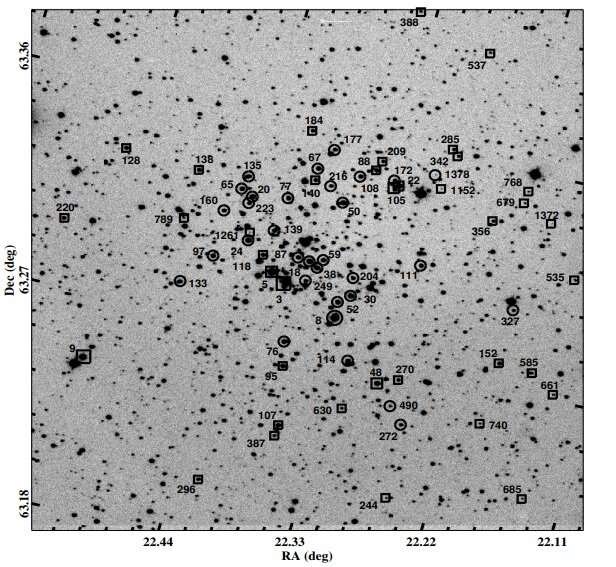September 23, 2020 report
Indian astronomers discover 70 new variable stars

Astronomers from India have conducted a long-term photometric variability survey of an open cluster known as NGC 559. As a result, they detected 70 new variable stars in the field of this cluster. The finding is presented in a paper published September 15 on the arXiv pre-print repository.
Star clusters offer excellent opportunities to study stellar evolution as they are collections of stars with similar properties, for instance, age, distance and initial composition. In particular, astronomers often search for variable stars in young and intermediate-age clusters, which could be crucial in advancing the understanding of pre-main-sequence (PMS) stars, and therefore the initial phases of stellar evolution.
Located at a distance of about 7,900 light years away from the Earth, NGC 559 is an open cluster estimated to be around 224 million years old. Previous observations of NGC 559 have identified 542 member stars and found that the cluster has a reddening at a level of 0.82 mag, and that its radius containing half the members is about 4.86 arcmin.
Now, a team of astronomers led by Yogesh C. Joshi of the Aryabhatta Research Institute of Observational Sciences (ARIES) in India have published the results of a long-term photometric study of NGC 559 as part of a broader monitoring campaign of some poorly studied young and intermediate-age open clusters. For this purpose, they used various 1-meter to 2-meter class telescopes located in India. The observations, lasting more than three years, resulted in the discovery of dozens of new variables in NGC 559.
"This work presents first long-term photometric variability survey of the intermediate-age open cluster NGC 559. We have carried out an extensive multi-site campaign to gather V band photometric data of the cluster field on 40 nights spanning over a period of more than three years," the astronomers wrote in the paper.
All in all, the study detected 70 new variable stars, out of which 67 are periodic variables with periodicities ranging from three hours to 41 days. The vast majority of the newfound periodic variables have periods below one day and most of them have relatively small amplitude of variability down to 0.02 mag level.
Among the all periodic variables reported in the paper, 30 were confirmed as cluster members (with estimated masses between 1.72 and 3.6 solar masses), while 37 belong to the field star population. Eleven member stars were classified as non-pulsating variables, five as rotational variables, three as slowly pulsating B-type stars, two as FK Comae Berenices-type variables, one as Algol type eclipsing binary, and one as a possible blue straggler star. The nature of seven members remains to be determined.
The astronomers noted that the remaining three stars out of the 70 reported in the study are irregular variables—two cluster members and one filed star. However, additional photometric and spectroscopic observations are required to shed more light into the nature of these objects.
More information: Joshi et al., Variable stars in the field of intermediate-age open cluster NGC 559, arXiv:2009.06997 [astro-ph.SR] arxiv.org/abs/2009.06997
© 2020 Science X Network




















